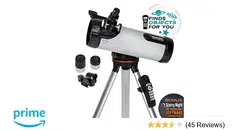
1
Celestial Observing
English
What can you see with your telescope? This section covers
visual observing hints for solar system and deep sky objects
as well as general observing conditions which will affect your
ability to observe.
The larger the aperture of your telescope, the easier it is to
locate and observe objects. Many amateurs use the phrase
“there is no substitute for aperture” which is true, but many
newcomers and especially young people begin with small
aperture telescopes, and as their interest levels grow, so can
their aperture requirements.
Other fascinating targets include the five naked eye planets
— keep in mind that the larger the aperture of your telescope,
the more detail you can see on the planets. You can see Venus
go through its lunar-like phases. Mars can reveal a host of
surface detail and one, if not both, of its polar caps. You will be
able to see the cloud belts of Jupiter and the great Red Spot
(if it is visible at the time you are observing). In addition, you
will also be able to see the moons of Jupiter as they orbit the
giant planet. Saturn, with its beautiful rings, is easily visible at
moderate power.
A planisphere or star charts for the current time and date, will
help you locate what planets are visible and where.
Planetary Observing Hints
• Remember that atmospheric conditions are usually the
limiting factor on how much planetary detail will be visible.
So, avoid observing the planets when they are low on the
horizon, or when they are directly over a source of radiating
heat, such as a rooftop or chimney. See the “Seeing
Conditions” section later in this manual.
• To increase contrast and bring out detail on the planetary
surface, try using eyepiece filters.
Often, it is tempting to look at the Moon when it is full. At this
time, the face we see is fully illuminated, and its light can be
overpowering. In addition, little or no contrast can be seen
during this phase.
One of the best times to observe the Moon is during its
partial phases (around the time of first or third quarter). Long
shadows reveal a great amount of detail on the lunar surface.
At low power, you will be able to see most of the lunar disk
at one time. Change to optional eyepieces for higher power
(magnification) to focus in on a smaller area.
lunar Observing Hints
To increase contrast and bring out detail on the lunar surface,
use optional eyepiece filters. A yellow filter works well at
improving contrast while a neutral density or polarizing filter will
reduce overall surface brightness and glare.
Observing the Planets
Observing the MOOn
Loading ...
Loading ...
Loading ...
